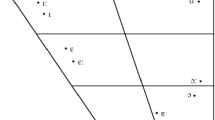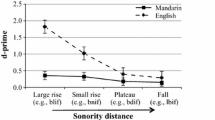Abstract
In this paper, we show that a high-ranking syllable contact constraint is the driving force behind the well-known nasalization and lateralization phenomena in Korean. Previous analyses of Korean nasalization and lateralization have accounted for the patterns of alternation by reference to rules of various types and rule ordering, with more recent analyses incorporating feature geometry with underspecification. While some of the previous research has indeed noted the importance of syllable contact as a motivating force behind the Korean nasalization and lateralization phenomena, such research has been unable to directly formalize the role that syllable contact plays in Korean phonology. After first presenting the Korean data that highlights the importance of syllable contact, we develop an optimality-theoretic analysis of Korean nasalization and lateralization in which SyllCon is an undominated constraint. The high ranking nature of this constraint determines which underlying consonantal sequences undergo alternation. The specific type of alternation (lateralization or nasalization) is determined by the lower ranking constraints. We compare our analysis with previous approaches to the Korean nasalization and lateralization problem found in the literature and argue for the superiority of the optimality-theoretic approach.
Similar content being viewed by others
Reference
Alderete, John (1995) “Winnebago Accent and Dorsey' Law,” University of Massachusetts Occasional Papers 18, 21–51.
Bat-El, Outi (1996) “Selecting the Best of the Worst: The Grammar of Hebrew Blends,” Phonology 13, 283–328.
Beckman, Jill (1997a) “Positional Faithfulness,” talk presented at the Hopkins Optimality Workshop/University of Maryland MayFest, Baltimore.
Beckman, Jill (1997b) “Positional Faithfulness, Positional Neutralization and Shona Vowel Harmony,” Phonology 14, 1–46.
Blevins, Juliette (1994) “A Place for Lateral in the Feature Geometry,” Journal of Linguistics 30, 301–348.
Cho, Young-mee Yu (1991) “The Conditions for Korean Assimilation,” ms., Stanford University.
Davis, Stuart and Seung-Hoon Shin (1997) “Is There a Syllable Contact Constraint?” poster paper presented at the Hopkins Optimality Workshop/University of Maryland MayFest, Baltimore.
Eulenberg, Alex (1996) “Sonority Constraints on Kazakh Affixes,” ms., Indiana University.
Goldsmith, John (1990) Autosegmental and Metrical Phonology, Blackwell, Oxford.
Green, Antony (1997) The Prosodic Structure of Irish, Scotts Gaelic, and Manx, PhD dissertation, Cornell University.
Hargus, Sharon (forthcoming) The Phonology and Morphology of Witsuwit'en, Clarendon Press, Oxford.
Harris, John (1990) “Segmental Complexity and Phonological Government,” Phonology 7, 255–300.
Hooper, Joan (1976) An Introduction to Natural Generative Phonology, Academic Press, New York.
Iverson, Gregory and Shinsook Lee (1994) “Variation as Optimality in Korean Cluster Reduction,” talk presented at Eastern States Conference on Linguistics (University of South Carolina, Columbia).
Iverson, Gregory and Hyang-Sook Sohn (1994) “Liquid Representation in Korean,” in Y. Kim-Renaud (ed.), Theoretical Issues in Korean Linguistics, CSLI, Stanford, pp. 77–100.
Kenstowicz, Michael (1993) “Syllabification in Chuckchee: A Constraints-Based Approach,” Formal Linguistics Society of Midamerica IV, 160–181.
Kenstowicz, Michael (1995) “Base Identity and Uniform Exponence,” in J. Durand and B. Laks (eds.), Current Trends in Phonology: Models and Methods, CNRS, Paris, pp. 366–396.
Kim-Renaud, Young-Key (1991) Korean Consonantal Phonology, Hanshin Publishing, Seoul.
Landau, Idan (1997) “Weight-by-Cycle,” MIT Working Papers in Linguistics 30, 183–208.
Lombardi, Linda (1995) “Why Place and Voice are Different: Constraint Interactions and Featural Faithfulness in Optimality Theory,” ms., University of Maryland.
McCarthy, John and Alan Prince (1995) “Faithfulness and Reduplicative Identity,” University of Massachusetts Occasional Papers 18, 249–384.
Miglio, Viola (1998) “Epenthesis and Deletion in Mantuan,” University of Maryland Working Papers in Linguistics 7, 81–109.
Murray, Robert and Theo Vennemann (1983) “Sound Change and Syllable Structure in Germanic Phonology,” Language 59, 514–528.
Pierrehumbert, Janet (1993) “Dissimilarity in the Arabic Verbal Roots,” NELS 23, 367–381.
Raffelsiefen, Renate (1995) “Conditions for Stability: The Case of Schwa in German,” ms., Heinrich Heine University, Dusseldorf.
Rice, Keren (1992) “On Deriving Sonority: A Structural Account of Sonority Relationships,” Phonology 9, 61–99.
Rice, Keren and Peter Avery (1991) “On the Relationship between Laterality and Coronality,” in C. Paradis and J. F. Prunet (eds.), Phonetics and Phonology 2: The Special Status of Coronals, Academic Press, San Diego, pp. 101–124.
Rose, Sharon (1997) Theoretical Issues in Comparative Ethio-Semitic Phonology and Morphology, PhD dissertation, McGill University.
Shaw, Patricia (1991) “Consonant Harmony Systems: The Special Status of Coronal Harmony,” in C. Paradis and J. F. Prunet (eds.), Phonetics and Phonology 2: The Special Status of Coronals, Academic Press, San Diego, pp. 125–157.
Shim, Minsu (1995) “Syllabification and Consonant Cluster Simplification in Korean,” Formal Linguistics Society of Midamerica VI, 50–61.
Shin, Seung-Hoon (1997) Constraints Within and Between Syllables: Syllable Licensing and Contact in Optimality Theory, PhD dissertation, Indiana University.
Smith, Jennifer (1997) “Markedness and Liquid Alternations in Korean: Implications for the Representation of Ambisyllabicity,” poster paper presented at the Hopkins Optimality Workshop/University of Maryland MayFest, Baltimore.
Sohn, Hyang-Sook (1987) Underspecification in Korean Phonology, PhD dissertation, University of Illinois at Urbana-Champaign.
Tak, Jin-young (1997) Issues in Korean Consonantal Phonology, PhD dissertation, Indiana University.
Urbanczyk, Suzanne (1996) Patterns of Reduplication in Lushootseed, PhD dissertation, University of Massachusetts, Amherst.
van Oostendorp, Marc (1995) Vowel Quality and syllable Projection, PhD dissertation, Tilburg University.
Vennemann, Theo (1988) Preference Laws for Syllable Structure, Mouton de Gruyter, Berlin.
Author information
Authors and Affiliations
Rights and permissions
About this article
Cite this article
Davis, S., Shin, SH. The Syllable Contact Constraint in Korean: An Optimality-Theoretic Analysis. Journal of East Asian Linguistics 8, 285–312 (1999). https://doi.org/10.1023/A:1008335414055
Issue Date:
DOI: https://doi.org/10.1023/A:1008335414055




